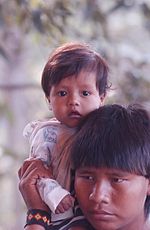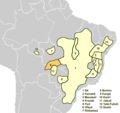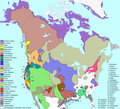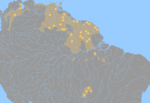 | Karajá, also known as Iny rybè, is spoken by the Karajá people in some thirty villages in central Brazil. There are distinct male and female forms of... 30 KB (3,344 words) - 13:28, 23 November 2023 |
Karaja or Karajá may refer to: Karajá, an indigenous tribe of Brazil Karajá language Karaja (singer) (born 1978), German musician Karaja, Iran, a village... 318 bytes (80 words) - 11:50, 3 July 2023 |
known as Apyãwa) is a Tupí-Guaraní language of Brazil. Ribeiro (2012) finds a number of Apyãwa loanwords in Karajá (such as bèhyra ‘carrying basket’,... 2 KB (127 words) - 05:40, 8 March 2024 |
An endangered language is a language that it is at risk of falling out of use, generally because it has few surviving speakers. If it loses all of its... 26 KB (85 words) - 02:47, 12 March 2024 |
 | Voiced alveolar implosive (category Articles containing Karajá-language text) alveolar implosive is a type of consonantal sound, used in some spoken languages. The symbol in the International Phonetic Alphabet that represents this... 7 KB (490 words) - 01:37, 31 March 2024 |
Consciously devised language Endangered language – Language that is at risk of going extinct Ethnologue#Language families Extinct language – Language that no longer... 34 KB (217 words) - 13:32, 22 April 2024 |
Mẽbêngôkre has been in contact with the distantly related Karajá language, as evidence by a number of Karajá loanwords in Mẽbêngôkre, especially in the dialect... 41 KB (3,265 words) - 05:59, 26 March 2024 |
 | The indigenous languages of South America are those whose origin dates back to the pre-Columbian era. The subcontinent has great linguistic diversity... 62 KB (4,809 words) - 10:48, 8 February 2024 |
Xambioá (redirect from Karajá do Norte) people in 1959. Karajá do Norte population is slowly beginning to recover. The present Karajá do Norte population is 268 people. KARAJÁ DO NORTE Archived... 2 KB (126 words) - 22:29, 27 April 2020 |
Andative and venitive (category Articles containing Tokelauan-language text) sumerologists use the variant term ventive rather than venitive. Karajá, a Macro-Jê language of central Brazil, is unusual in requiring all verbs to be inflected... 9 KB (1,221 words) - 02:37, 29 November 2023 |
Puinave-Nadahup languages, Jolkesky (2016) notes that there are lexical similarities with the Tupian, Harakmbet, Katukina-Katawixi, Arawak, and Karaja language families... 6 KB (683 words) - 17:47, 10 October 2022 |
 | northwestern Jê; the Xavante, the Xerente, and the Akroá of the central Jê; the Karajá; the Jeikó; the Kamakán; Maxakalí; the Guayaná; the Purí (Coroado); the... 2 KB (99 words) - 08:22, 23 July 2023 |
Zayn al-Din Qaraja (redirect from Karaja Beg) Zayn al-Din Qaraja Beg (Turkish: Zeyneddin Karaca Bey; c. 1279 – 11 December 1353) was a Turkoman chieftain who founded the Dulkadirid principality in... 13 KB (1,495 words) - 01:46, 7 February 2024 |
Bolivia Moxos – Bolivia Ignaciano – Bolivia Trinitario – Bolivia Macro-Gê Karajá Gê Kaingáng Canela Tupian Tupinambá – Brazil Guaraní – Paraguay Chiriguano... 12 KB (669 words) - 05:03, 10 June 2023 |
 | Bananal Island (category Articles containing Portuguese-language text) populate the island. At least four tribes live on Bananal Island: the Javaés, Karajá, Ava-Canoeiro, and Tuxá. There are sixteen aldeias or villages on the island:... 5 KB (417 words) - 01:52, 31 December 2023 |
 | Araguaia River (category Articles containing Portuguese-language text) The Araguaia River (Portuguese: Rio Araguaia [ˈʁi.u aɾaˈɡwajjɐ], Karajá: ♂ Berohokỹ [beɾohoˈkə̃], ♀ Bèrakuhukỹ [bɛɾakuhuˈkə̃]) is one of the major rivers... 11 KB (826 words) - 03:13, 3 April 2024 |
with titles beginning with Karaya All pages with titles containing Karaya Karaja (disambiguation) This disambiguation page lists articles associated with... 982 bytes (170 words) - 05:46, 3 July 2023 |
its distinct Brazilian percussion, ambient field noise, and chanting. A Karajá man features on the cover of the album. "True" native metal (heavy metal... 14 KB (1,140 words) - 06:24, 19 December 2023 |
 | Javaés River (category CS1 Portuguese-language sources (pt)) south. List of rivers of Tocantins Nunes, Eduardo S. (2016). Transformações Karajá. Os “antigos” e o “pessoal de hoje” no mundo dos brancos (Ph.D. dissertation)... 2 KB (122 words) - 05:45, 9 May 2023 |
Masakará † (Masacará) Kapixaná (Kanoê, Capixana) Karajá (Caraja, Xambioá, Chamboa, Ynã, Karayá) Karajá-Xambioá † (Chamboa, Ynã) Javaé (Javaje, Javae) Karirían... 190 KB (4,385 words) - 07:43, 23 November 2023 |
 | Aromanians (category CS1 Romanian-language sources (ro)) native to the southern Balkans who speak Aromanian, an Eastern Romance language. They traditionally live in central and southern Albania, south-western... 77 KB (7,865 words) - 21:56, 26 April 2024 |
 | List of Indigenous peoples of Brazil (category Articles containing Portuguese-language text) Indigenous or Native peoples. This is a sortable listing of peoples, associated language families, Indigenous locations, and population estimates with dates. A... 42 KB (497 words) - 00:44, 17 December 2023 |








